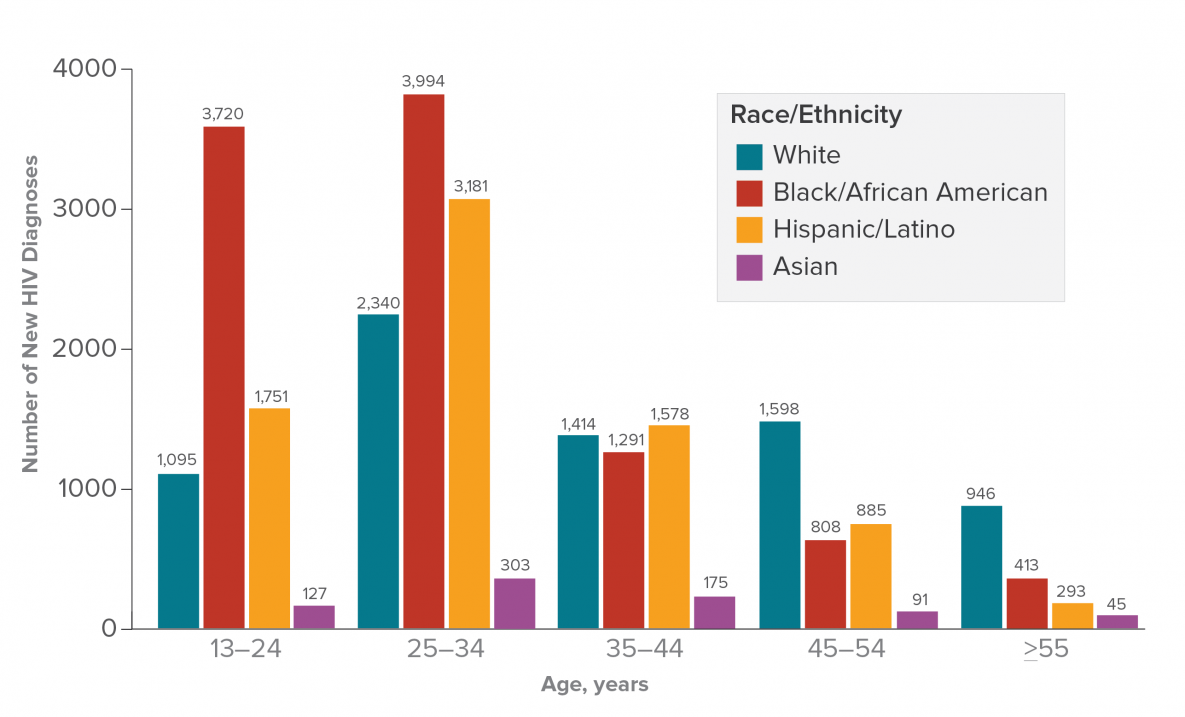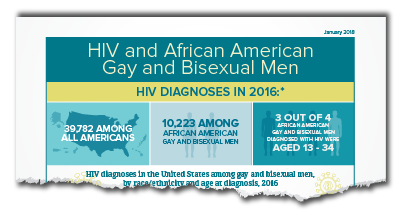HIV and African American Gay and Bisexual Men
Black/African Americana gay and bisexual menb are more affected by HIV than any other group in the United States. In 2016, African American gay and bisexual men accounted for 25% (10,226) of the 40,324 new HIV diagnosesc and 38% of new diagnoses among all gay and bisexual men in the United States and 6 dependent areas.d
The Numbers
HIV Diagnosese
In 2016:
- Among all gay and bisexual men who received an HIV diagnosis in the United States and 6 dependent areas, African Americans accounted for the highest number (10,226; 38%), followed by Hispanics/Latinosf (7,689; 29%) and whites (7,392; 28%). Other races/ethnicities accounted for 1,537 (6%) diagnoses among gay and bisexual men.
- Thirty-six percent (3,720) of African American gay and bisexual men who received an HIV diagnosis were aged 13 to 24; 39% (3,994) were aged 25 to 34; 13% (1,291) were aged 35 to 44; 8% (808) were aged 45 to 54; and 4% (413) were aged 55 and older.
From 2011 to 2015:
HIV diagnoses remained stable among all African American gay and bisexual men. Trends for HIV diagnoses among African American gay and bisexual men varied by age.
- Ages 13 to 24: Remained stable.
- Ages 25 to 34: Increased 30%.
- Ages 35 to 44: Decreased 12%.
- Ages 45 to 54: Decreased 25%.
- Ages 55 and older: Decreased 4%.
HIV Diagnoses Among Gay and Bisexual Men
By Age and Race/Ethnicity in the United States and 6 Dependent Areas, 2016

Subpopulations representing 2% or less of HIV diagnoses among gay and bisexual men are not reflected in this chart.
Source: Diagnoses of HIV infection in the United States and dependent areas, 2016. HIV Surveillance Report 2017;28.
Living With HIV
In the 50 states and the District of Columbia:
- An estimated 1,122,900 people had HIV at the end of 2015.g African American gay and bisexual men accounted for 18% (201,800) of all people with HIV and 32% of all gay and bisexual men with HIV.
- Among African American gay and bisexual men with HIV in 2015, an estimated 80% had received a diagnosis.
In 37 states and the District of Columbia:h
- Among all African American gay and bisexual men who received an HIV diagnosis in 2015, 69% were linked to HIV medical care within 1 month.
- Among all African American gay and bisexual men who received an HIV diagnosis in 2013 or earlier, 71% received HIV medical care in 2014, 54% received continuous HIV care, and 52% had a suppressed viral load.i A person with HIV who takes HIV medicine as prescribed and gets and stays virally suppressed or undetectable can stay healthy and has effectively no risk of sexually transmitting HIV to HIV-negative partners.
Deaths
In 2015, there were 2,037 deaths among African American gay and bisexual men with diagnosed HIV in the United States and 6 dependent areas. These deaths may be due to any cause.
Prevention Challenges
Stigma, homophobia, and discrimination put gay and bisexual men of all races/ethnicities at risk for multiple physical and mental health problems and may affect whether they seek and are able to receive high-quality health services, including HIV testing, treatment, and other prevention services. In addition to stigma and other risk factors affecting all gay and bisexual men, several factors are specific to African American gay and bisexual men. These include:
- Lack of awareness of HIV status. Among people who have HIV, a lower percentage of African American gay and bisexual men know their HIV status compared to gay and bisexual men of some other races/ethnicities.j People who do not know they have HIV cannot take advantage of HIV care and treatment and may unknowingly pass HIV to others.
- Timely linkage to HIV medical care. According to a recent MMWR, only 67% of HIV-positive African American gay and bisexual men with newly diagnosed HIV, and 58% with previously diagnosed HIV were linked to HIV medical care. Early linkage to HIV medical care is essential to achieving viral suppression.
- Low rates of viral suppression. African American gay and bisexual men have lower rates of viral suppression compared to gay and bisexual men of other races/ethnicities. Because of the low rates of viral suppression and the higher prevalence of HIV in that population relative to other races/ethnicities, African American gay and bisexual men are at greater risk of being exposed to HIV.
- Socioeconomic factors. Having limited access to quality health care, lower income and educational levels, and higher rates of unemployment and incarceration may place some African American gay and bisexual men at higher risk for HIV than men of some other races/ethnicities.
What CDC Is Doing
CDC funds state and local health departments and community-based organizations (CBOs) to deliver effective HIV prevention services for African American gay and bisexual men. For example:
- Under the current funding opportunity, CDC will award around $400 million per year to health departments for surveillance and prevention efforts. This funding opportunity will direct resources to the populations and geographic areas of greatest need while supporting core HIV surveillance and prevention efforts across the United States.
- In 2017, CDC awarded nearly $11 million per year for 5 years to 30 CBOs to provide HIV testing to young gay and bisexual men of color and transgender youth of color, with the goals of identifying undiagnosed HIV infections and linking those who have HIV to care and prevention services.
- In 2015, CDC added three funding opportunities to help health departments reduce HIV infections and improve HIV medical care among gay and bisexual men.
- Targeted Highly-Effective Interventions to Reverse the HIV Epidemic (THRIVE) supports state and local health department demonstration projects to develop community collaborations that provide comprehensive HIV prevention and care services for gay and bisexual men of color.
- Training and Technical Assistance for THRIVE strengthens the capacity of funded health departments and their collaborative partners to plan, implement, and sustain (through ongoing engagement, assessment, linkage, and retention) comprehensive prevention, care, behavioral health, and social services models for gay and bisexual men of color at risk for and living with HIV infection.
- Project PrIDE (PrEP, Implementation, Data2Care, and Evaluation) supports 12 health departments in implementing pre-exposure prophylaxis (PrEP) and Data to Care demonstration projects for gay and bisexual men.
- The Capacity Building Assistance for High-Impact HIV Prevention is a national program that provides training and technical assistance for health departments, CBOs, and healthcare organizations to help them better address gaps in the HIV continuum of care and provide high-impact prevention for people at high risk for HIV.
- Through its Act Against AIDS campaigns and partnerships, CDC provides African American gay and bisexual men with effective and culturally appropriate messages about HIV prevention and treatment. For example,
- Start Talking. Stop HIV. helps gay and bisexual men communicate about safer sex, testing, and other HIV prevention issues.
- Doing It, a national HIV testing and prevention campaign, encourages all adults to know their HIV status and protect themselves and their community by making HIV testing a part of their regular health routine.
- HIV Treatment Works shows how people living with HIV have overcome barriers to stay in care and provides resources on how to live well with HIV.
- Partnering and Communicating Together (PACT) to Act Against AIDS,a 5-year partnership with organizations such as the National Black Justice Coalition and the Black Men’s Xchange, is raising awareness about testing, prevention, and retention in care among populations disproportionately affected by HIV, including African American gay and bisexual men.
To learn more about health issues affecting gay and bisexual men, visit the CDC Gay and Bisexual Men’s Health site.
a Referred to as African American in this fact sheet.
b The term male-to-male sexual contact is used in CDC surveillance systems. It indicates a behavior that transmits HIV infection, not how individuals self-identify in terms of their sexuality. This fact sheet uses the term gay and bisexual men.
c The numbers reported in this fact sheet include infections attributed to male-to-male sexual contact only, not those attributed to male-to-male sexual contact and injection drug use (men who reported both risk factors).
d American Samoa, Guam, the Northern Mariana Islands, Puerto Rico, the Republic of Palau, and the US Virgin Islands.
e HIV diagnoses refers to the number of people who received a diagnosis of HIV during a given time period, not when the people were infected.
f Hispanics/Latinos can be of any race.
g Includes diagnosed and undiagnosed HIV infections.
h These jurisdictions are included because they had complete reporting of CD4 and viral load results to CDC.
i People are considered retained in care if they get two viral load or CD4 tests at least 3 months apart in a year. (CD4 cells are the cells in the body’s immune system that are destroyed by HIV.) Viral suppression is based on the most recent viral load test.
j Though African American gay and bisexual men report higher HIV testing in the past year than Hispanic/Latino or white gay and bisexual men, they also have a higher prevalence of HIV. That means a greater proportion of those who have not been tested recently are HIV-positive.
Bibliography
- CDC. Diagnoses of HIV infection in the United States and dependent areas, 2016. HIV Surveillance Report 2017;28.
- CDC. Estimated incidence and prevalence in the United States 2010-2015. HIV Surveillance Supplemental Report 2018;23(1).
- CDC. Monitoring selected national HIV prevention and care objectives by using HIV surveillance data—United States and 6 dependent areas, 2016. HIV Surveillance Supplemental Report 2018;23(4).
- CDC. HIV infection risk, prevention, and testing behaviors among men who have sex with men—National HIV Behavioral Surveillance, 20 U.S. cities, 2014. HIV Surveillance Special Report 2016;15.
- CDC. HIV surveillance—Men who have sex with men (slides). Accessed July 30, 2018.
- CDC. High-impact HIV prevention: CDC’s approach to reducing HIV infections in the United States. Accessed July 30, 2018.
- CDC. HIV care outcomes among blacks with diagnosed HIV–United States, 2014. MMWR 2017;66(4):97-103.
- CDC. HIV care outcomes among men who have sex with men with diagnosed HIV infection—United States, 2015. MMWR 2017;66(37):969-74.
- CDC. HIV infection risk, prevention, and testing behaviors among men who have sex with men—national HIV behavioral surveillance, 20 U.S. cities, 2014. HIV Surveillance Special Report 2016;15.
- CDC. HIV testing experience before HIV diagnosis among men who have sex with men—21 jurisdictions, United States, 2007–2013. MMWR 2016;65(37):999-1003.
- CDC. New HIV infections drop 18 percent in six years (press release). Accessed July 30, 2018.
- Habarta N, Boudewyns V, Badal H, et al. CDC’S testing makes us stronger (TMUS) campaign: Was campaign exposure associated with HIV testing behavior among black gay and bisexual men? AIDS Educ Prev 2017;29(3):228-40. Pubmed abstract.
- Kwan CK, Rose CE, Brooks JT, Marks G, Sionean C. HIV testing among men at risk for acquiring HIV infection before and after the 2006 CDC recommendations. Public Health Rep 2016;131(2):311-9. PubMed abstract.
- Marano M, Stein R, Song W, et al. HIV testing, linkage to HIV medical care, and interviews for partners services among Black men who have sex with men—Non-health care facilities, 20 Southern U.S. jurisdictions, 2016. MMWR 2018;67(28):778-81.
Other Resources
Web Sites
- Gay and Bisexual Men’s Health
- Lesbian, Gay, Bisexual, and Transgender Health
- Positive Spin
- National Gay Men’s HIV/AIDS Awareness Day
- National Black HIV/AIDS Awareness Day
General Resources
- CDC-INFO 1-800-CDC-INFO (232-4636)
- CDC HIV Website
- CDC Act Against AIDS Campaign
- CDC HIV Risk Reduction Tool (BETA)
- Page last reviewed: September 26, 2018
- Page last updated: September 26, 2018
- Content source: Division of HIV/AIDS Prevention, National Center for HIV/AIDS, Viral Hepatitis, STD, and TB Prevention, Centers for Disease Control and Prevention


 ShareCompartir
ShareCompartir

